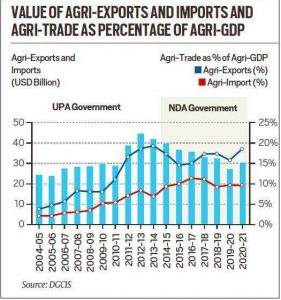From UPSC perspective, the following things are important :
Prelims level: Agri-exports from India
Mains level: Paper 3- Issues with India's agri-exports
The article highlights the unsustainability of agri-exports owing to their water-intensive nature and subsidies provided in their production.
India’s agri-exports
- Agri-exports touched $41.8 billion in FY 2020-21, registering a growth of 18 per cent over the previous year.
- Amongst the various agri-commodity exports, rice ranks first with 17.7 million tonnes valued at $8.8 billion, roughly 21 per cent of the total value of agri-exports.
- It is followed by marine products ($6 billion), spices ($4 billion), bovine (buffalo) meat ($3.2 billion) and sugar ($2.8 billion).

Trend analysis of agri-exports
- During the last seven years, agri-exports have remained lower than the level reached in FY2013-14 ($43.3 billion).
- That was when the highest agri-trade surplus (exports minus imports) was generated ($27.8 billion).
- That was also when Indian agriculture was most globally integrated, with agri-trade (exports plus imports) touching 20 per cent of the agri-GDP.
- It has slid to 13.5 per cent by FY2020-21, indicating India is becoming less globally competitive in exports and more protectionist in imports, presumably in the name of Atmanirbhar Bharat.
- It is high time to review current agri-trade policies and accompanying tariff structures.

Why sustainability of agri-exports is a concern?
- From a strategic point of view, however, one must ask whether this growth rate can be sustained over a longer period, and the implications it has for Indian agriculture.
- Water consumption: India is a water-stressed country with per capita water availability of 1,544 cubic metres in 2011, down from 5,178 cubic metres in 1951.
- It is well known that a kg of sugar has a virtual water intake of about 2,000 litres.
- In 2020-21, India exported 7.5 million tonnes of sugar, implying that at least 15 billion cubic metres of water was exported through sugar alone.
- Rice, needs around 3,000 to 5,000 litres of water for irrigating a kg, depending upon topography.
- Also, rice cultivation contributes to more than 18 per cent of the GHG emission generated from agriculture.
- Subsidies: Power and fertiliser subsidies account for about 15 per cent of its value in states like Punjab and Haryana.
- If these subsidies are withdrawn, rice will not be as preferred a crop with farmers as it is today.
Way forward
- Farming practices such as alternate wetting drying (AWD), direct-seeded rice (DSR) and micro-irrigation will have to be taken up on a war footing.
- Farmers may be incentivised and rewarded to save water, switch from paddy and sugar to other less water guzzler crops, and reduce the carbon footprint.
- It is high time that policymakers revisit the entire gamut of rice and sugar systems from their MSP/FRP to their production in an environmentally sustainable manner.
- At least in the case of rice, procurement will have to be limited to the needs of PDS, and within PDS, it is high time to introduce the option of direct cash transfers.
Consider the question “Rice and sugar forms the part of India’s agri-basket. However, there are concerns over their sustainability. What are the reasons for concerns and suggest the measure to deal with these concerns”
Conclusion
To maintain the sustainability of the agri-exports, crops must be produced efficiently and with minimal subsidies. The government needs to take steps to ensure that with rice and sugar.
Get an IAS/IPS ranker as your 1: 1 personal mentor for UPSC 2024

